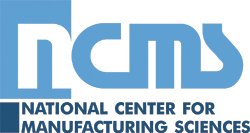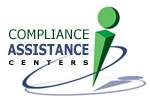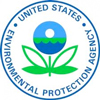 |
 |
**This page is under construction**
P2 Research and Implementation for
Michigan Metal Finishers (PRIM)
This section of STERC contains several project products developed by the National Center for Manufacturing Sciences under EPA Grant Number: 00E02050. This project was funded under EPA’s Source Reduction Assistance Grant Program. This program funds Pollution Prevention (P2) assistance projects that provide technical assistance and/or training to businesses/facilities to help them adopt source reduction approaches.
The goal of this project, P2 Research and Implementation for Michigan Metal Finishers or PRIM, was to reduce information barriers that prevent widespread implementation of pollution prevention (P2) technologies and approaches by the metal finishing industry with a focus on innovative P2 methods.
Overall project management was conducted by NCMS. The original NCMS project manager, Bill Chenevert, who initiated the project, retired during the course of the project and was replaced by Lisa Strobierski, who managed the project through completion. Bill Chenevert and Lisa Strobierski were also responsible for communicating with the EPA Region 5 Project Manager, Donna Twickler. Much of the project technical work was performed by NCMS contractor, CAI Resources. CAI’s key project personnel included George Cushnie and Paul Chalmer.
The National Association for Surface Finishing (NASF is the major US metal finishing trade association); and AESF Foundation (the major US metal finishing educational society) were primary partners during the project. Throughout the project, these two organizations coordinated communications with the metal finishing industry and encouraged the participation of both P2 technology providers and metal finishing facilities. The primary NASF/AESF Foundation representative was Jeff Hannapel. The final PRIM report can be downloaded here.
Industry Survey. A survey was conducted to compare current metal finishing shops’ environmental performance with established environmental benchmarks for water use, energy use, toxic releases and environmental costs. Both hardcopy and on-line versions of the survey were prepared. The two versions were developed for the convenience of potential respondents with the objective of increasing the rate of participation. The Phase 1 survey collected basic environmental and production data for all metal finishing shops. The Phase 2 survey collected detailed information, cost data and process-specific P2 practices.
The Phase 1 survey was mailed to Michigan metal finishing shops and to NASF member shops US-wide (a total of 600 shops). The mailed package included a cover letter, instructions, the Phase 1 survey and a postage paid return envelope. In the cover letter, as an incentive to participate, NCMS offered to give each Phase 1 survey respondent a copy of the NCMS-published book: Pollution Prevention and Control Technologies for Plating Operations. Companies were asked to return Phase 1 surveys within two weeks.
A total 83 Phase 1 surveys were received. Of that total, 35 surveys were considered complete. Most of the incomplete surveys were the on-line version. Due to the relatively low response, it was not be possible to update the benchmarking work that was performed by NCMS in 2000. However, an analysis was performed that compares shops in the current study to the respondents from the 2000 survey. The results indicate that a significant percentage of shops performed better from an environmental standpoint in 2016 than in 2000. A statistical analysis of the data is presented here.
Development of Rinsing Manual. Results from the PRIM survey and observations during facility visits suggested that a systematic method of evaluating rinsing and developing plans for improved water use is needed by the surface finishing industry. A number of articles, reports and guidance manuals provide relatively good, but less than complete information. As a result, under this project, NCMS developed a comprehensive guide (Rinsing Manual) to evaluating and improving rinsing practices based on actual results. The guide contains instructions for conducting a rinse survey and detailed descriptions of good rinsing practices. Data, pictures, video and examples from the PRIM survey and facility visits were incorporated into the manual. The manual is available for public use at no charge as an on-line STERC tool. The Rinsing Manual is available for public use on STERC.
Rinsing Improvement Project. To test the use of the Rinsing Manual, a project was conducted on a zinc/nickel electroplating line at a Michigan metal finishing facility. As discussed above, one of the key reasons for selecting a Zn/Ni line was the relative absence of P2 information for this process.
Following the Rinsing Manual procedures, surveys of the Zn/Ni line were performed on multiple dates and recommended improvements were developed and presented to facility management. The facility decided to implement five of those suggestions. After that work was completed, the project team returned to measure the impacts of the improvements. A capsule report covering this work can be found here.
Demonstration of the Coventya low nickel EN bath chemistry. Electroless nickel (EN) plating is an autocatalytic process used to deposit nickel-phosphorus alloy onto metal or plastic substrates to impart corrosion and/or wear resistance. Performed without the use of an electric current, this process gained commercial popularity in the 1950’s and has grown into an immensely popular surface coating technology. Two significant pollution issues associated with EN plating are rinsing and bath disposal. Rinse water from this process contains chelated nickel that presents problems with wastewater treatment; the nickel is more difficult to precipitate than the nickel from common electrolytic processes. Periodic EN bath disposal is necessary because byproducts of the process buildup and the solution becomes unusable. The spent bath is difficult to treat on-site and expensive to ship off-site for disposal.
Most EN baths are formulated with 6 g/l nickel. Coventya has developed a low nickel solution that operates at 3 g/l nickel. A demonstration of the technology was performed to determine the P2 benefits of the lower nickel bath chemistry, with a focus on rinsing and bath disposal. The project was performed at a Michigan metal finishing facility.
During the P2 demonstration, Coventya replaced an existing 6 g/L mid-phosphorus EN bath with a 3 g/l nickel mid-phosphorus bath. The new bath contains approximately 50% less nickel (3g/l). Testing included sampling of rinse tanks for both the existing and new electroless nickel processes. A capsule report covering this work can be found in here.
Demonstration of the Coventya Zn/Ni 3S Technology. The Coventya 3S Technology is applicable to zinc/nickel electroplating baths. The technology uses a porous barrier to divide the bath into an anode and cathode compartment. Electrolyte is recirculated through the anode compartment, which is maintained at a head slightly above that of the cathode compartment, allowing a slow continuous flow of electrolyte. In this configuration, possibly assisted by ion-selective permeability of the barrier, the migration of organic components present in the cathode compartment into the anode compartment is impeded. In ordinary zinc/nickel baths, these compounds are oxidized when they reach the anode, forming cyanide and undesirable carbonates. The 3S technology avoids production of these contaminants. In addition, preventing unwanted side reactions should increase current efficiency, and recirculating anode electrolyte should draw heat away from the bath, reducing power requirements of plating and cooling.
A facility was selected for the demonstration based on the manufacturer’s recommendation. The facility had recently installed a zinc/nickel plating line and the 3S technology. At the start of the project, the plating line was undergoing auto industry approvals. This work was delayed for months and a decision was made to move the demonstration to a different facility. The second facility, located in Chicago, had the 3S technology installed and fully operational.
Data provided by the Chicago facility indicates that the 3S technology was effective in limiting the production of cyanide. In addition, the power consumed per amount of product plated showed about a 10% improvement in the 3S process compared to a standard zinc/nickel line running at the same facility. An indication of higher water consumption per product plated measured for the 3S process remains unexplained. A capsule report covering this work can be found here.
 |
 |
 |
The information contained in this site is provided for your review and convenience. It is not intended to provide legal advice with respect to any federal, state, or local regulation.
You should consult with legal counsel and appropriate authorities before interpreting any regulations or undertaking any specific course of action.
Please note that many of the regulatory discussions on STERC refer to federal regulations. In many cases, states or local governments have promulgated relevant rules and standards
that are different and/or more stringent than the federal regulations. Therefore, to assure full compliance, you should investigate and comply with all applicable federal, state and local regulations.